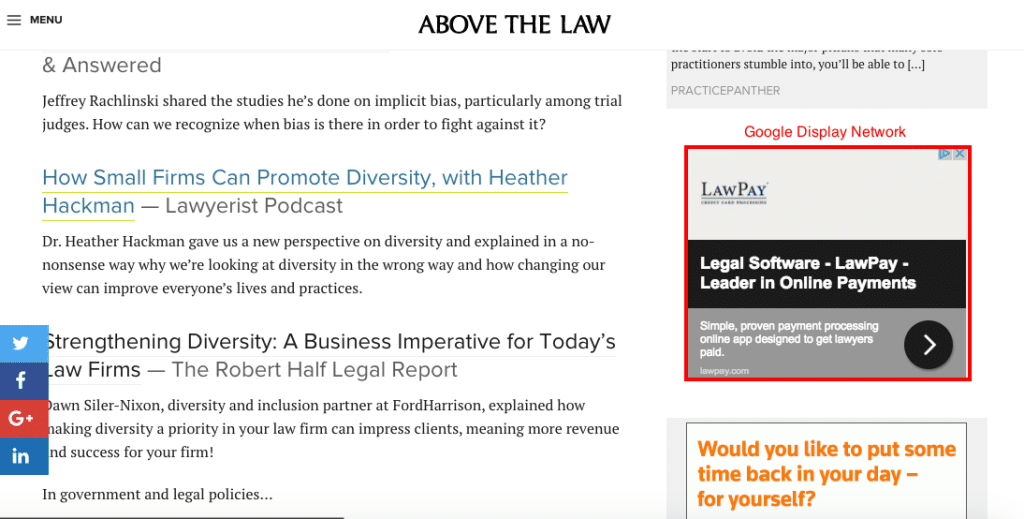Menu
March 23rd, 2017
In the world of online marketing, remarketing is the ability to show your ads to people on other websites, after they've left your website. Your intention is to bring them back to your own website again at some point. Remarketing programs use cookies (which are essentially digital tags) to identify individual web browsers that land on your website. They thus create a list of potentially interested clients — or, at least, specific browsers used by such clients — and later display your ads elsewhere on the Internet to those potential clients for a period of 1 to 540 days.
But that's just the really short version of the story. Let's talk more about the why and how of remarketing.
Why? Remarketing = Intention Filtering
The best advertising uses information about potential clients' needs or wants to target marketing dollars for the highest return on investment. When clients shop for services online, you can get very specific information about what they need. Put otherwise, you can learn a lot about their intentions by what they type into Google, what they share on social media, or what websites they visit.
Good online marketing tools allow you to filter web surfers based on those intentions in order to put your ads before targeted audiences more likely to be actively looking to hire you. (Google AdWords is an obvious example. Ideally you aim your ads at search phrases that evince a high degree of intention — say, "I need a real estate lawyer close by me," as opposed to simply "real estate law.")
Remarketing helps you capitalize on the fact that a visit to your website is, itself, a signal for intent. The fact that someone clicked on your website at some point is a strong indicator that they are in the market for your type of services. Remarketing ads are a powerful way to follow that intent and continue building your offer.
How? Remind the Right Web Users That You're Out There and Provide What They Need
You most likely have seen this before. Let's say you go to Amazon to look up Bluetooth headphones. After browsing around, you're not quite ready to buy a pair and continue on to other work. Later that evening, while browsing Facebook, you notice an ad in your feed for the exact same headphones you were looking at earlier that day. That's remarketing at work: Amazon knows you like these headphones and may need an extra bump or reminder to get you to buy.
There are several networks that display remarketing ads. The two that we will cover are the Google Display Network and Facebook's Remarketing Network. These sites are "free" to use, and then show ads in order to make their money. As a testament to how powerful these networks can be, Facebook reported $27.64 billion in revenue in 2016 and Google reported a staggering $74.54 billion.
These networks are like other ad platforms in that you have a high degree of control over your ads. You get to build your ads, choose who they target, control the monthly budget, and even decide how often your ads will be shown.
GDN (Google Display Network)
Google offers content producers (i.e. website owners, bloggers) a way to monetize the traffic to their sites by showing ads on some portion of the sites.
To show ads on this network of sites, Google charges advertisers (your firm) if, and only if, someone clicks on your ad. Google then splits the fee you pay with the ad publisher (the website/blog where the ad showed up). In return you, of course, get traffic to your site by handpicked potential clients, with the aim of converting them into viable leads.
You can show ads in two formats: graphics, as depicted above, and text. The most popular option is graphical, since it attracts more attention.
Pros of Google Display Network
- Large network. Google claims that over two million sites feature the GDN, reaching 90% of people on the Internet. Since a huge draw of the Internet is free content, publishers are enticed to install the network in order to make money by putting out new content (without have to charge directly for that content).
- Cheaper than AdWords. The GDN is cheaper than the Google Search Network. Google has two networks to show ads: GDN, and the Google Search Network. The latter is used when someone types a search directly into Google ("I need a real estate attorney"). They then sell advertisers the top 4 and bottom 3 spots on that results page as a method of driving traffic to your site. Since the information is much more direct, and a client is actively searching for your services at that moment, economics drive those prices up. By using the GDN, you are sacrificing the timing (someone may be reading about dog training on a pet site, not thinking about their need for a lawyer) but bringing your cost-per-click way down.
Cons of Google Display Network
- Users may not be in the right mindset. As we just discussed above, the GDN is placed on websites that may have nothing to do with law, and your client may be looking for other information at that particular time. In exchange, you get cheaper cost-per-clicks. It's very important to have a compelling offer with your ads to ensure that customers will want to pull away from what they're doing and revisit your site. With law, it can be a bit difficult to have a promotional offer, so you have to stick with what makes you unique and offering a professional appearance to reset their intentions.
- The annoyance factor. GDN ads can potentially be annoying. Most of us have had the experience of, after visiting some website, having an ad from that site following you everywhere on the Internet for a while. Further, since this type of marketing is so new, people are still a bit cautious of how advertisers are targeting them. For these reasons, it is important to keep your per-day ad impressions low. Luckily, the GDN allows you to select as low as 1 impression per day to people on your remarketing list in order to minimize being overbearing.
Facebook's Ad Network
Facebook.com also has its own ad network, which it shares with its subsidiary, Instagram, and partner websites. Just like Google, Facebook generates a tremendous amount of its revenue through showing ads to its users. Rather than place code on other people's websites, Facebook uses the massive traffic to its own site to show ads. In the fourth quarter of 2016, Facebook claimed it had 1.86 BILLION active users, defined by those who had logged in at least once in the last 30 days.
While similar to the GDN, Facebook offers some unique opportunities and challenges.
Pros of Facebook Remarketing Ads
- Advanced demographic information. Since Facebook's users tend to share everything about themselves, Facebook has an excellent profile of everyone. And it shares that data with its advertisers. This means that, when you advertise on its network, Facebook allows you to view detailed information about your potential customers: gender, age, household income, education, location and much more. This can help you further target your ads for greater success.
- More noticeable ads. Facebook ads tend to be a little louder than ads on the GDN. Since Facebook's ads can be directly in your feed, they are bigger and more noticeable. As you're scrolling through, you see a photo of someone's new baby, a status update about the local sports team, and then an ad.
Cons of Facebook Remarketing Ads
- The intrusion factor. As a brand new technology, remarketing has a little something about it that some people still aren't used to. Minds are used to compartmentalization (why would Amazon products I liked show up on Facebook?), and people are wary of their data being mined and used online. As this kind of data use becomes a more common practice, we believe that people will become accustomed to this as a normal part of using the Internet. Still, this is why the substance of your ad is so important: you want to remain as professional as possible and nail exactly what the client is looking for. The more you can make your ads feel beneficial to them, and not just you, the better reception your ads will get.
- Higher Cost-Per-Click. Since Facebook offers more direct views of your ad with strong demographic information, the marketplace has raised the prices for remarketing. While still not as costly as Google's Search Network, Facebook has become a popular choice for advertisers and the cost-per-click of remarketing ads is higher than for Google's Display Network. We still find it to be an excellent platform, and almost always worth a test to see how it affects traffic and lead generation for your particular firm.
Remarketing can go even further beyond the scope of this article. If you have more questions, email marketing@themodernfirm.com and we'll be happy to go over the options with you.
Tags: Advertising







